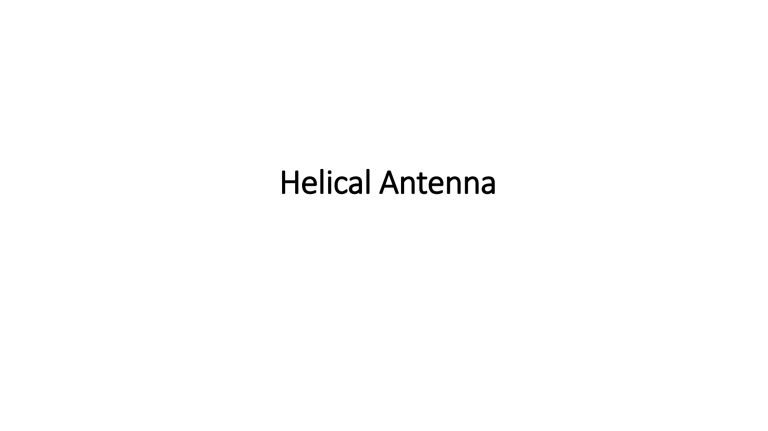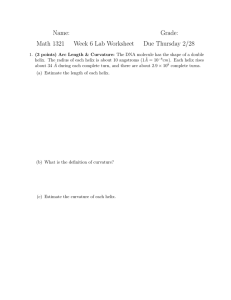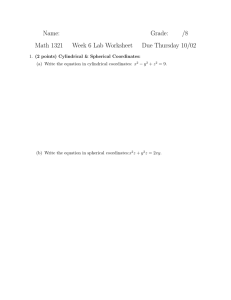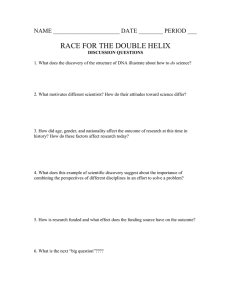
Helical Antenna Broadband (2:1) Antenna used in VHF (30-300 MHz, FM radio broadcasting, television broadcasting, twoway land mobile radio systems ,long range data communication up to several tens of kilometers with radio modems, amateur radio, and marine communications. Air traffic control communications and air navigation systems) and UHF (300MHz and 3 GHz, television broadcasting, cell phones, satellite communication including GPS, personal radio services including Wi-Fi and Bluetooth, walkietalkies, cordless phones, ) ranges. Provides Circular Polarization Electromagnetic radiator is that of a conducting wire wound in the form of a screw thread forming a helix The helix is used with a ground plane Diameter of ground plane should be 3λ/4 The ground plane can also be cupped in the form of a cylindrical cavity If one turn of helix is uncoiled D= diameter of helix C= circumference of helix S=spacing between turns α= pitch angle Lo= length of one turn N= number of turns L= axial length/ helix length 2a= diameter of helix conductor L = NS total helix length total length of the wire where Pitch Angle When α = 0, the spacing between turns=0 making it a loop antenna of N turns When α = 900 the diameter of helix = 0 the helix reduces to a linear antenna 00<α < 900 – true helix is formed The radiation characteristics of the antenna can be varied by controlling the size of its geometrical properties compared to the wavelength. The input impedance is critically dependent upon the pitch angle and the size of the conducting wire, especially near the feed point, and it can be adjusted by controlling their values. The general polarization of the antenna is elliptical. However circular and linear polarizations can be achieved over different frequency ranges. Modes of operation 1. Normal Mode (broadside mode)- radiation is intense in the direction normal to the axis of the helix ( perpendicular) and null along the axis similar to small loop or a small dipole 2. Axial Mode ( end fire mode)- radiation along the axis of the helix Because an elliptically polarized antenna can be represented as the sum of two orthogonal linear components in timephase quadrature, a helix can always receive a signal transmitted from a rotating linearly polarized antenna. Therefore helices are usually positioned on the ground for space telemetry applications of satellites, space probes, and ballistic missiles to transmit or receive signals that have undergone Faraday rotation by traveling through the ionosphere. Normal Mode To achieve the normal mode of operation, the dimensions of the helix are usually small compared to the wavelength (NL0 ≪ λ0). The geometry of the helix reduces to a loop of diameter D when the pitch angle approaches zero and to a linear wire of length S when it approaches 90◦. Since the limiting geometries of the helix are a loop and a dipole, the far field radiated by a small helix in the normal mode can be described in terms of E𝜃 and E𝜙 components of the dipole and loop, respectively Combination of N small loops and N short dipoles connected together in series The fields are obtained by superposition of the fields from these elemental radiators. The planes of the loops are parallel to each other and perpendicular to the axes of the vertical dipoles. The axes of the loops and dipoles coincide with the axis of the helix. Small loop of diameter D and short dipole of length S Due to small dimensions current is constant two components are in time-phase quadrature, a necessary but not sufficient condition for circular or elliptical polarization. AR = 0 when EѲ = 0 representing linear horizontal polarization – helix becomes horizontal loop i.e S =0 AR = infinity when D=0, making EФ = 0 , helix becomes vertical dipole- linear vertical polarization AR = 1 when Resulting in CP Drawbacks of normal mode 1. Due to small dimensions radiation efficiency is low 2. Narrow BW Design A five turn helical antenna in the normal mode at 400 MHz. The spacing between turns is λ/50. It is desired that the antenna possesses CP. Determine the 1. Circumference of the helix ( in λ and meters) 2. Length of a single turn ( in λ and meters) 3. Overall length of the helix ( in λ and meters) 4. Pitch angle in degrees Axial Mode of Helical Antenna Pattern Multiplication: In an array total field= Element factor X Array Factor Element factor: Depends on type of element Array factor: depends on 1. distance between the elements 2. Progressive phase shift 3. Number of elements φ = K d cos θ + β φ sinN 2 AF = φ N sin 2 For AF to be maximum φ = 0 φ = K d cos θ + β = 0 β = −K d cos θ For end fire case Ѳ = 0/ 180 β = −kd/ + kd Helical Antenna To achieve axial mode of operation D and S should be large fractions of wave length To achieve CP 4/3 3 λ 4 4 3 <C< λ fu/fl = 3/4 = 16/9= 1.78 ~ 2 which satisfies Broadband requirement Phase difference between opposite points of the loop is zero. So in far-field helix gives maximum radiation due to reinforcement Helix is considered as an array of identical turns placed along Z axis S- distance between elements φ = K S cos θ + β = 0 β = −K S cos θ Helix radiates along 0 direction β = −K S Phase shift between elements As C~λ current travelling through the loop introduces additional delay of 2π β = −K S − 2π Velocity Factor: velocity of wave travelling through helix conductor < velocity of wave in free space P= v/c If for one turn of length on helical conductor phase shift is β = −𝑘1 𝐿𝑜 β = −K S − 2π = −𝑘1 𝐿𝑜 K S + 2π = 𝑘1 𝐿𝑜 φ = K S cos θ + β = 0 φ = KScosθ − k1Lo φ = K Scosθ − k1Lo Lo = K Scosθ − k P Specifications of a helical antenna designed at a center frequency of 475 MHz are HPBW=39 deg, pitch angle= 12.5 deg Circumference of one turn is equal to one wave length at the center frequency. Calculate 1. The number of turns needed 2. Directivity in dB 3. Axial Ratio 4. Over what range of frequencies will these parameters remain relatively constant 5. The input impedance at the design frequency and at the ends of the band. • References • C. A. Balanis, Antenna Theory: Analysis and Design (3rd eds.), John Wiley & Sons, Hoboken, NJ, 2005. • www.wikipedia.org





